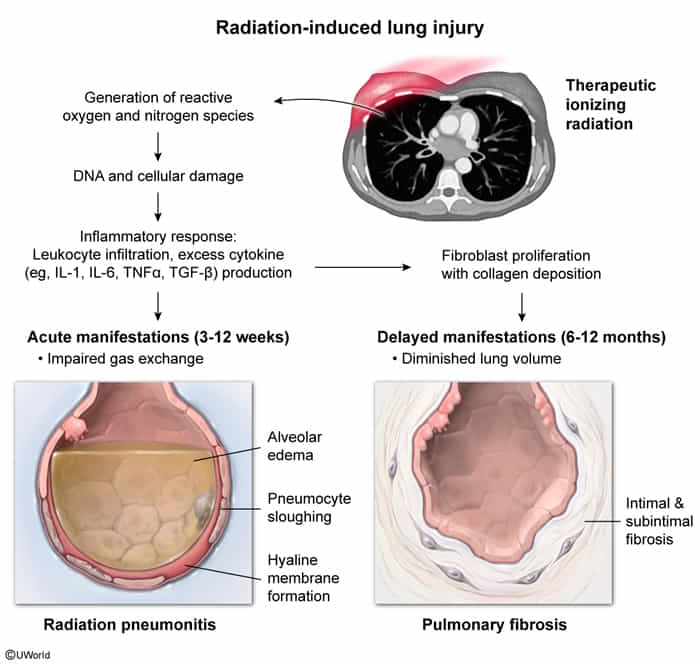Radiation injury
High doses of ionizing radiation (e.g., radiotherapy, nuclear accidents) cause DNA and cellular damage via reactive oxygen species and photons or particles, which cause inflammation and progressive tissue damage. Certain rapidly regenerating tissues (e.g., skin, gastrointestinal tissue, bone marrow) are more susceptible due to the depletion of immature parenchymal stem cells. Cancerous cells are more susceptible to radiation than healthy cells due to their high replication rates and dysfunctional DNA repair mechanisms. Easily affected cells:
- GI: Intestinal crypt stem cells
- Bone marrow: hematopoietic progenitors (pancytopenia)
- Gonads: spermatogonia (infertility)
- Skin: basal keratinocytes, hair follicle stem cells (desquamation, hair loss)
Acute radiation syndrome
Skin and mucosa (these are rapidly regenerating tissues)
- Erythema, desquamation, blisters, ulcers, necrosis
- Stomatitis, dysphagia
- Cataracts
- Hair loss
- Radiation dermatitis
- Acute (<90 days after radiotherapy):
- Apoptosis of basal keratinocytes and epidermal edema
- Dose-dependent effects ranging from erythema to desquamation (ie, skin peeling), superficial ulceration, and/or blistering
- Pigment changes and loss of skin appendages (eg, hair follicles, sebaceous glands)
- Late (months to years after radiotherapy):
- Fibrosis, characterized histologically by homogenization of dermal collagen, due to fibroblast activation by transforming growth factor-beta from damaged tissue and responding immune cells
- Vascular damage, resulting in chronic hypoxia and ulceration
- Abnormal, dilated microvasculature (ie, telangiectasias)
- Acute (<90 days after radiotherapy):
Respiratory
- Early radiation-induced lung injury: radiation pneumonitis
- Usually develops within 3–12 weeks of radiation
- Caused by an acute release of proinflammatory cytokines (e.g., IL-1, IL-6)
- Common symptoms: dyspnea, dry cough, hemoptysis, and fever (patients may be asymptomatic)
- Partial respiratory insufficiency is an early sign.
Chronic radiation injury
Results in fibrosis and/or cancer
Respiratory
- Late radiation-induced lung injury: radiation fibrosis
- Usually develops after 6–12 months of radiation
Genitourinary
- Impaired fertility
- Ovarian, vulvar and/or vaginal fibrosis, amenorrhea
- Azoospermia
- Urethral and ureteral stenosis, lead to Urinary incontinence
- Bladder fibrosis
- Obstructive uropathy